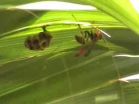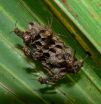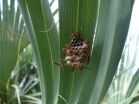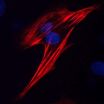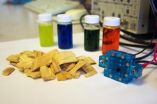(Press-News.org) VIDEO:
This video shows a female wasp marked with pink paint that was a recently accepted non-nestmate who became a subordinate worker. A resident female flies in and forces the newly...
Click here for more information.
Coral Gables, Fla. (Feb. 17, 2014) -- Ants, wasps and humans live in highly complex societies. Our organizations share some basic features of group life, like individuals trying to find the balance between cooperation and conflict. Understanding what factors are important for these communities to develop gives us key insights into the evolution of sociality in animals.
A new study, by University of Miami (UM) biologist Floria Mora-Kepfer Uy, looks at colonies of social wasps and explores the acceptance of individuals not related to each other, in a highly organized and adaptable society. The findings show that the age of the individual, and of the colony, defines the costs and benefits of accepting new members into a group.
The study uses the social wasp Mischocyttarus mexicanus. "These colonies are composed exclusively of females and they make decisions on the colony composition depending on the social and ecological pressures they are exposed to," says Mora-Kepfer Uy, a lecturer in the College of Arts & Sciences.
Nest-switching is common during the initial period of colony establishment, when individual wasps try to join other colonies and existing members have to decide whether to accept or reject new comers. The wasps recognize nestmates from non-nestmates using chemical signals that are specific to each colony.
"If non-nestmates are accepted, they may either become a worker in the colony or instead attempt to take over the reproductive-dominant role, steal, or cannibalize the colony's offspring," says Mora-Kepfer Uy. "Females are, therefore, trying to balance the potential benefits of having additional help with the possible costs of new members acting selfishly."
According to the study, young non-nestmates were accepted more often than old ones, and they were more frequently accepted into young colonies, than in late colonies. It might favor the colony to accept non-nestmates as subordinate workers during the period of colony establishment. The findings also show that late colonies more frequently rejected both young and old non-nestmates, suggesting that risk of acceptance may be too high at this stage.
"The findings imply that the effect of the social context and immediate needs of a group mediate social acceptance in these flexible societies," says Mora-Kepfer Uy. "These factors may help us understand changes in the composition of other complex animals groups, including human societies,"
INFORMATION:
The study is titled "Context-dependent acceptance of non-nestmates in a primitively eusocial insect." The findings are published in the journal Behavioral Ecology and Sociobiology
What cooperation and conflict in an insect's society can teach us about social acceptance
University of Miami biologist finds that social wasps are accepted more frequently into unfamiliar colonies when both the individual and the group are young
2014-02-18
ELSE PRESS RELEASES FROM THIS DATE:
UCI study finds specific genetic cue for sudden cardiac death syndrome
2014-02-18
Irvine, Calif., Feb. 18, 2014 — UC Irvine researchers have found a specific genetic flaw that is connected to sudden death due to heart arrhythmia – a leading cause of mortality for adults around the world.
While a number of genes have been linked with arrhythmias, UC Irvine's Geoffrey Abbott and his colleagues discovered that the functional impairment of a gene called KCNE2 underlies a multisystem syndrome that affects both heart rhythm and blood flow and can activate chemical triggers that can cause sudden cardiac death.
"With these findings, we can now explore improved ...
RealeyeZ Takes 3D Animation to the Next Level with RealHD MooV
2014-02-18
Online shoppers are accustomed to viewing consumer products in 360 degrees. Now RealeyeZ3D is taking the power of RealHD to the next level. Their new product, RealHD MooV, offers moving features that are not available elsewhere in video or 3D marketing and merchandising.
"RealHD Moov uses the MPEG-4 movie format," says company founder and CEO, Ofer Rubin. "It is compatible with Apple and all other platforms and responsive to all screen sizes. Together with its new scalability. It will look like retailers spent tens of thousands of dollars on high-end TV ...
Ion beams pave way to new kinds of valves for use in spintronics
2014-02-18
Researchers at the Helmholtz-Zentrum Dresden-Rossendorf (HZDR) have tested a new approach to fabricating spin valves. Using ion beams, the researchers have succeeded in structuring an iron aluminium alloy in such a way as to subdivide the material into individually magnetizable regions at the nanometer scale. The prepared alloy is thus able to function as a spin valve, which is of great interest as a candidate component for use in spintronics. Not only does this technology use electron charge for purposes of information storage and processing, it also draws on its inherent ...
Study uncovers surprising differences in brain activity of alcohol-dependent women
2014-02-18
BLOOMINGTON -- A new Indiana University study that examines the brain activity of alcohol-dependent women compared to women who were not addicted found stark and surprising differences, leading to intriguing questions about brain network functions of addicted women as they make risky decisions about when and what to drink.
The study used functional magnetic resonance imaging, or fMRI, to study differences between patterns of brain network activation in the two groups of women. The findings indicate that the anterior insular region of the brain may be implicated in the ...
85 percent of heart attacks after surgery go undetected due to lack of symptoms
2014-02-18
Without administering a simple blood test in the first few days after surgery, 85 percent of the heart attacks or injuries patients suffer could be missed, according to a study in the March issue of Anesthesiology. Globally, more than 8 million adults have heart attacks or injuries after surgery every year, and 10 percent of those patients die within 30 days.
The study suggests a new diagnosis, Myocardial Injury after Noncardiac Surgery (MINS), would be useful to physicians because of its broader definition from what is traditionally used to diagnose heart attacks now. ...
Chance of falling after knee replacement not increased by regional anesthesia
2014-02-18
Two types of regional anesthesia do not make patients more prone to falls in the first days after having knee replacement surgery as some have previously suggested, according to a study based on nearly 200,000 patient records in the March issue of Anesthesiology.
Regional forms of anesthesia – spinal or epidural (neuraxial) anesthesia and peripheral nerve blocks (PNB) – which only numb the area of the body that requires surgery, provide better pain control and faster rehabilitation and fewer complications than general anesthesia, research shows. But some surgeons avoid ...
Obese patients who feel judged by doctors are less likely to shed pounds, study shows
2014-02-18
Overweight and obese people who feel their physicians are judgmental of their size are more likely to try to shed pounds but are less likely to succeed, according to results of a study by Johns Hopkins researchers.
The findings, reported online last week in the journal Preventive Medicine, suggest that primary care doctors should lose the negative attitudes their patients can sense if the goal is to get patients with obesity to lose 10 percent or more of their body weight — an amount typically large enough to reduce blood pressure, cholesterol and diabetes risk.
"Negative ...
Medicaid's 'tube-tying' polices create roadblocks for low-income women
2014-02-18
PRINCETON, N.J.—Tubal ligation – commonly referred to as having one's "tubes tied" – is widely used to prevent unintended pregnancies. However, current Medicaid policies create roadblocks for low-income women trying to obtain the procedure, according to a review written by researchers at Princeton University's Woodrow Wilson School and other U.S. institutions.
Under a Medicaid rule enacted in 1978, women must currently wait 30 days after signing a written consent form to obtain a tubal ligation. This requirement is prohibitive for many women who want to receive the ...
Can marijuana protect the immune system against HIV and slow disease progression?
2014-02-18
New Rochelle, NY, February 18, 2014—New evidence that chronic intake of THC, the primary psychoactive ingredient in marijuana, can protect critical immune tissue in the gut from the damaging effects of HIV infection is reported in AIDS Research and Human Retroviruses, a peer-reviewed journal from Mary Ann Liebert, Inc., publishers. The article is available free on the AIDS Research and Human Retroviruses website at http://www.liebertpub.com/aid.
Patricia Molina and coauthors from Louisiana State University Health Sciences Center, New Orleans, report that chronic THC administration ...
Solar-induced hybrid fuel cell produces electricity directly from biomass
2014-02-18
Although low temperature fuel cells powered by methanol or hydrogen have been well studied, existing low temperature fuel cell technologies cannot directly use biomass as a fuel because of the lack of an effective catalyst system for polymeric materials.
Now, researchers at the Georgia Institute of Technology have developed a new type of low-temperature fuel cell that directly converts biomass to electricity with assistance from a catalyst activated by solar or thermal energy. The hybrid fuel cell can use a wide variety of biomass sources, including starch, cellulose, ...
LAST 30 PRESS RELEASES:
Making lighter work of calculating fluid and heat flow
Normalizing blood sugar can halve heart attack risk
Lowering blood sugar cuts heart attack risk in people with prediabetes
Study links genetic variants to risk of blinding eye disease in premature infants
Non-opioid ‘pain sponge’ therapy halts cartilage degeneration and relieves chronic pain
AI can pick up cultural values by mimicking how kids learn
China’s ecological redlines offer fast track to 30 x 30 global conservation goal
Invisible indoor threats: emerging household contaminants and their growing risks to human health
Adding antibody treatment to chemo boosts outcomes for children with rare cancer
Germline pathogenic variants among women without a history of breast cancer
Tanning beds triple melanoma risk, potentially causing broad DNA damage
Unique bond identified as key to viral infection speed
Indoor tanning makes youthful skin much older on a genetic level
Mouse model sheds new light on the causes and potential solutions to human GI problems linked to muscular dystrophy
The Journal of Nuclear Medicine ahead-of-print tip sheet: December 12, 2025
Smarter tools for peering into the microscopic world
Applications open for funding to conduct research in the Kinsey Institute archives
Global measure underestimates the severity of food insecurity
Child survivors of critical illness are missing out on timely follow up care
Risk-based vs annual breast cancer screening / the WISDOM randomized clinical trial
University of Toronto launches Electric Vehicle Innovation Ontario to accelerate advanced EV technologies and build Canada’s innovation advantage
Early relapse predicts poor outcomes in aggressive blood cancer
American College of Lifestyle Medicine applauds two CMS models aligned with lifestyle medicine practice and reimbursement
Clinical trial finds cannabis use not a barrier to quitting nicotine vaping
Supplemental nutrition assistance program policies and food insecurity
Switching immune cells to “night mode” could limit damage after a heart attack, study suggests
URI-based Global RIghts Project report spotlights continued troubling trends in worldwide inhumane treatment
Neutrophils are less aggressive at night, explaining why nighttime heart attacks cause less damage than daytime events
Menopausal hormone therapy may not pose breast cancer risk for women with BRCA mutations
Mobile health tool may improve quality of life for adolescent and young adult breast cancer survivors
[Press-News.org] What cooperation and conflict in an insect's society can teach us about social acceptanceUniversity of Miami biologist finds that social wasps are accepted more frequently into unfamiliar colonies when both the individual and the group are young
